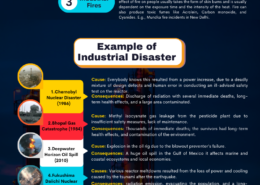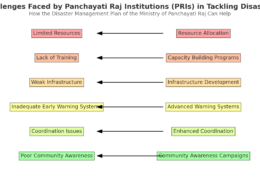Does a good disaster risk reduction formula involve community resilience?
Natural disasters are not a new phenomenon. History of the havoc of natural disasters is as old as the history of mankind on the face of planet earth. The urge for survival helped human beings to observe and study the behaviour pattern of Nature around them and prepare themselves for forthcoming disRead more
Natural disasters are not a new phenomenon. History of the havoc of natural disasters is as old as the history of mankind on the face of planet earth. The urge for survival helped human beings to observe and study the behaviour pattern of Nature around them and prepare themselves for forthcoming disasters. These observations are preserved in the form of traditional knowledge in the minds of local communities, which comes to rescue at the time of natural disasters. According to the World Risk Index, six out of the world׳s ten highest disaster risk countries are in Asia and the Pacific. Thus we find riches of traditional knowledge here to respond to disasters.
Some Of The General Observations Due To Traditional Knowledge
- Landslide: New cracks or unusual bulges in the ground or street pavements; Rapid increase in stream water levels; Sticking doors and windows and sudden decrease in stream water levels though rain is still falling or just recently stopped.
- Earthquake: Different behaviour of a particular variety of fish (Singhi) which comes to the top of the water level before an earthquake.
- Tornado: Sudden change in the colour of the sky.
- Floods: In coastal communities, since ancient times communities have been using bioindicators like Tree-Tempe-tank being situated at elevated areas is the safest flood shelter, black ants with eggs climbing up, symbolises heavy rain.
- Wildfires and desertification: Running cows indicates severity during village fire, the direction of wind indicates the weather forecast and growth of wild indicates desertification. These have over the years been culturally accepted and tested for successful results.
Some Successful Practices In India Using Traditional Knowledge
- The Kashmir region is known for its traditional earthquake-safe construction practices, where two types of construction practices are prevalent: Taq system (timber laced masonry) and Dhajji-Dewari system (timber frame with infill walls).
- Traditional Bamboo plantation in Northeast: Planting bamboo helps to protect the bunds from being breached and prevent rapid runoff from the river channel when the river overflows during heavy rainy days. Moreover, planting bamboo along fish ponds and paddy fields prevents soil erosion and stops water from submerging low areas during peak flooding days.
- In Tamil Nadu, to protect crops from floods, farmers plant flood-resistant paddy seed using indigenous agriculture practices. They broadcast the seeds in late summer and early monsoon without any chemical fertilizer, it grows well and before the flood season its root goes deep and the plant becomes strong. Such plants grow so well that during harvesting the plants are cut into two pieces; one is used for fodder and the other part for the annual renovation of thatched houses.
- In West Bengal and Odisha, to save fish from floods, farmers in the coastal regions put bamboo pegs in the fish pond before the flood and just before the pond submerges with flood water they hang fried fenugreek on these pegs at different places in a pond putting it in thin cotton cloths. As per the farmers, if the fried fenugreek is hanged inside the pond then the fishes don’t leave the pond. This considerably reduced the risk of washing away from the fishes in floodwater.
- Taanka is a traditional rainwater harvesting technique indigenous to the Thar desert region of Rajasthan. A Tanaka is a cylindrical paved underground pit into which rainwater from rooftops, courtyards or artificially prepared catchments flows. Once filled, the water stored in a tank can last throughout the dry season and is sufficient for a family of 5-6 members. Similar practices in the form of Johad, Khadin, Kund, and Baoli, etc. helps the communities to withstand the drought and harsh climate.
- Indigenous communities of Andhra Pradesh and other drought-prone areas practice shifting cultivation and grow drought-resistant tuber crops which follow a cycle providing enough space for conservation.
Some Examples From The Globe
- Tsunami in Indonesia: In the islands of Indonesia singing of the animal below is believed to work as a premonition of disaster. This phenomenon is used as an early warning sign for tsunami waves. This has significantly helped the tsunami vulnerable island community to take appropriate action on the tsunami warning.
- Floating Gardens of Bangladesh and Boat Schools: Many parts of Bangladesh are flooded either due to a large coastline in the Bay of Bengal or due to flooded rivers of the country. A novel method of farming in moving boats with the help of traditional knowledge has come to rescue the communities from economic impacts of frequent floods. Similarly, even in floods, students do not miss their classes due to Boat schools.
- Traditional predictions of calamities in Africa: In African countries, drought and occasional floods are common disasters. Communities predict the calamity by observing the height of the nests of the amahlokohloko bird (Ploceus spp.) on trees to predict floods. When floods are likely to occur the nesting of the amahlokohloko is very high up the trees next to a river and when floods are unlikely the nests are low down. They also used the cry of certain birds to predict rain and yields of certain wild fruit plants to predict famine.
The important role that local knowledge and practices can play in reducing risk and improving disaster preparedness is now acknowledged by disaster risk reduction specialists. However, they have yet to be commonly used by communities, scientists, practitioners and policy-makers. The local and indigenous knowledge needs to be integrated with science and advanced technologies before it can be used in policies, education, and actions related to disaster risk reduction and climate change.
See less



Disaster Risk Reduction (DRR) is a systematic approach to identifying, assessing, and reducing the risks of disaster. It aims to reduce socio-economic vulnerabilities to disaster as well as deal with the environmental and other hazards that trigger them. Community resilience is the sustained abilityRead more
Disaster Risk Reduction (DRR) is a systematic approach to identifying, assessing, and reducing the risks of disaster. It aims to reduce socio-economic vulnerabilities to disaster as well as deal with the environmental and other hazards that trigger them. Community resilience is the sustained ability of a community to use available resources (energy, communication, transportation, food, etc.) to respond to, withstand, and recover from adverse situations. This allows for the adaptation and growth of a community after disaster strikes. The scope of community resilience extends beyond natural disasters and includes man made ones too.
Role Of Community Resilience In Drr
Community Resilience Is Not Enough
Communities do not exist in isolation. The level of a community’s resilience is also influenced by capacities outside the community, in particular by emergency management services but also by other social and administrative services, public infrastructure, and a web of socio-economic and political linkages with the wider world. Apart from community resilience we need:
Disaster Management has to be a multi-disciplinary and proactive approach. Besides various measures for putting in place institutional and policy framework, disaster prevention, mitigation, community resilience, and preparedness have a key role to play in achieving our goal of moving together, towards a safer India.
See less